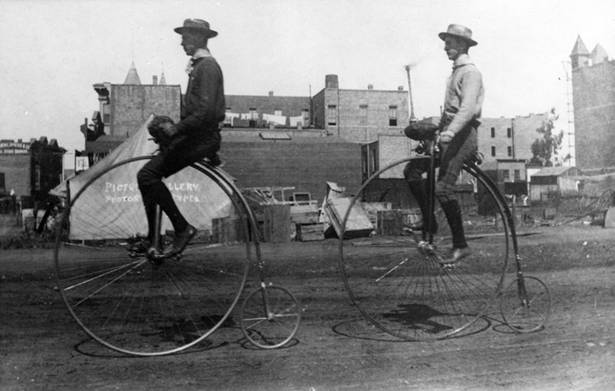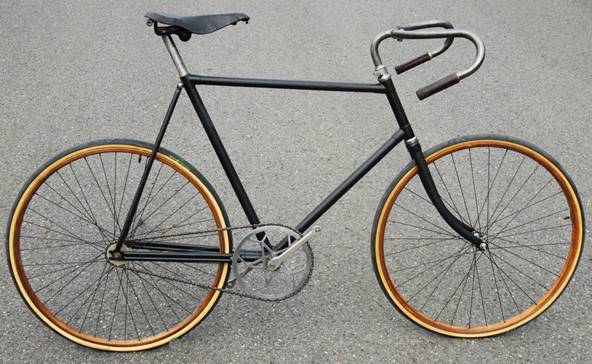Not Today's Bicycles
Early bicycles had been too primitive to race. The wooden bone shakers of the 1840s were slow and awkward, even tortuous to ride. By the 1870s, things had evolved; there were new bicycle frames made of metal tubing, wheels with tensioned wire instead of wooden spokes, and solid rubber tires. When these things came together, people realized that they had bicycles which they could race, and they did.
Like early airplanes, these bicycles were not sleek or lean. Indeed, they looked a bit ridiculous. In England, they were called penny farthings (i.e., a small coin next to a very large coin); in other countries, they were known as ordinaries. The nattily-attired young Californians below are not racing their machines; this must have been a pleasure ride. You can see how relaxed and carefree they are.
https://commons.wikimedia.org/wiki/File:Pennyfarthing-1886.jpg
Why were the front wheels so big? There were no gears; the rider pedaled a crank that was part of the front axle. For the ordinary to go faster than a child's tricycle, the front wheel had to be larger. To win races, it had to be MUCH larger, with a diameter of 60" or more. Ordinaries were fast (for their time) and they were dangerous. A fall, or even just climbing off, was risky. Moreover, there were no brakes. As with the bicycles used for modern sprints, to slow his machine, a cyclist resisted the turning of the pedals with his feet and leg muscles - something which was practically impossible when his legs were so fully extended as those in the picture above. To stop quickly, an accomplished "wheelman" leaned forward to grab the front tire and stop its rotation. In such a stop, he risked being catapulted over the ordinary's front wheel, and on the way forward his thighs might be impaled upon the handlebars. The racers of the day were not only dashing; they were daring.
Around the time that Jerome Steinert was born, bicycles advanced further. The advent of the bicycle chain made possible the use of different-sized gears on a crank and axle, a combination which made huge wheels obsolete. These features were combined in what became known as the safety bicycle. A few years later, the invention of inflatable tires made cycling even better. The example below (which is missing its pedals) is a well-preserved Czech-made safety.
sterba-bike.cz
Don't let the familiar appearance mislead you. These racers did not have "freewheeling" or "coaster" hubs; the pedals moved whenever the bicycle did - even in a 150 mile race.
In 1912, derailleurs had not yet been perfected, and they were not used in racing. Before a race began, a rider either chose a gear for the rear axle, or simply used the same gear he always used. Whether racing on level ground, up and down hills, on a wooden track or on a dirt road, mile after mile he used the same gear.
The safety type would never completely go away; year by year, it gradually evolved. Steinert doubtlessly pedaled a safety in his youth, and he certainly raced one. They were much less risky than ordinaries - for one thing, you didn't have as far to fall, and a rider might be able to land on his feet. There still were no brakes, for in that era, bicycle brakes quickly wore down tires, and sometimes caused punctures, but at least the strong legs of the rider were better positioned to use the pedals for slowing his machine.
Of course, having safer machines only encouraged cyclists to take more chances. Wheelmen were still dashing and daring.
The next Hicksville Athletic Club games, in which the A.C. (Steinert was a founding member when the organization began in 1905) competed against representatives of other athletic associations, occurred only eight weeks after Steinert's injury. With barely time to recover, Pete chose to race. Although the level of competition probably did not match what he had faced at Vailsburg, he must have been pleased to win both the one-half mile and five mile races.
|
|
|
A drawback of relying on old newspapers for research is that not all of them have survived, and there are gaps. The extant newspapers show almost no evidence of Steinert's racing in 1910. Perhaps he had little time for the sport due to his job (he was an underwriter for an electric utility). It seems more likely, however, that he needed a prolonged period to heal completely, and then to get his body back into racing condition - which he eventually did. Reports in two 1911 newspapers indicate that he must have done some racing in the prior year, for they refer to Pete's having been the 1910 U.S. National Champion in the quarter-mile. Continued respect for his cycling was further reinforced in 1911, by his winning a half-mile race at the 12,500 seat Newark Velodrome, after which a newspaper reported that Pete Steinert had "regained his form."

https://thecabe.com/forum/threads/toc-tracks-and-velodromes.125781/
That September, Hicksville A.C. held a Cycling Carnival competition, and Steinert had a remarkable day. He had the fastest absolute time in the five mile handicap; he took five seconds off the national record for the one-quarter mile, and he also set a new two mile record, eleven seconds better than the old. He definitely was back.



